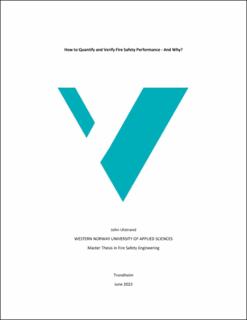| dc.description.abstract | This thesis explores ways to improve the framework for performance-fire safety engineering of buildings.
Performance-based building codes have been widely adopted, as they allow regulators to set the ambitions by policies and functional requirements, thus leaving the choice of technology and solutions to the designers in building projects. Compared to the traditional prescriptive approach, where dimensions, solutions, and performance levels are specified, performance-based design is meant to provide more flexibility – a highly attractive feature considering the rate of change in the building industry and in society as a whole.
Some jurisdictions introduced performance-based building regulations for fire safety in the 1990s, all with a slightly different approach to the mandatory and non-mandatory contents. It is furthermore of utmost importance to consider the accompanying support structures – a term meant to encompass authority involvement or oversight in the building application process. As in Norway, this can also be privatised through accepting public responsibility for design, control, or third-party review, and hence, the qualifications, competencies, and ethics of the practitioners are important components of the support structure. Similarly, accountability and sanctions are components of the same support structure.
The review of the current Norwegian Building Regulations shows that fundamentally different approaches are used to the different chapters, where some chapters are prescriptive, some are regulated by performance criteria, many have functional requirements, supplemented with pre-accepted performance levels, either in the guide to the regulations, or in national or international standards.
The chapter on safety in case of fire has functional requirements, but also includes mandatory provisions (prescriptive). The review has exemplified a bias in the regulation towards a building tradition, which in some cases is obsolete, thus creating barriers for performance-based design. Pre-accepted performance levels are of great importance for interpreting the functional requirements and are often used as benchmark for analytical design.
Verification is the process of demonstrating that the design is in compliance with the functional requirements. Different methods exist, typically categorised by whether they are numerical (quantitative) or non-numerical (qualitative), if they evaluate against absolute criteria or to a reference building known to be compliant (comparative), and finally, whether the uncertainty is treated by conservative single assumptions (deterministic) or if the uncertainty is quantified and treated as random variables (probabilistic).
Various metrics for fire safety performance are assessed. The aim of this exercise is to identify means for regulators to increase regulatory control by expressing explicit values representing acceptable risk – preferably on a global building scale, allowing for full flexibility regarding design choices for technology and strategy.
The inherently stochastic nature of fire science and human interaction results in significant uncertainty embedded in any analysis of fire safety at the design stage for buildings. The identified metrics can therefore not in isolation give adequate certainty of outcome but must be seen in context of the verification method used and the treatment of the uncertainty.
Alternatives to verification are discussed, where emphasis is put on the support structure, to allow for relaxations to the verification. The concepts of socio-technical system for fire safety engineering are gaining momentum and is identified as a candidate to replace verification. Although scenario analysis and many other established tools and techniques within fire safety engineering can be repurposed in systemic thinking, the concept of verification must be abandoned, in favour of definitions of safety constraints, information loops, capable of keeping the system in a state of safety in a life cycle perspective.
It seems fire safety engineering is at a crossroads, where one road means to further pursue verification by science-based expressions. Here, the challenges are an immense need for data, lack of specific guidance and criteria, and lastly, inadequate methodologies for treating the substantial uncertainty. The alternative is to enforce regulation of the practitioners to a degree where society find confidence in the design adequacy without verification. In this alternative, systemic thinking can fit, when further advanced, but also established concepts like risk assessment and ALARP could be applied.
Calls for more holistic fire safety design are discussed, where barriers are identified, and remedies are proposed. For the Norwegian regulatory framework, the main barrier is the regulatory segregation between the Planning and Building Act, governing design and construction, and the Fire and Explosion Prevention Act, governing the operation of (existing) buildings, fire prevention, and the fire and rescue service. The thesis proposes to initiate the considerable task of merging the legislations, but also points to several short-term improvements to mitigate the identified challenges. | en_US |

